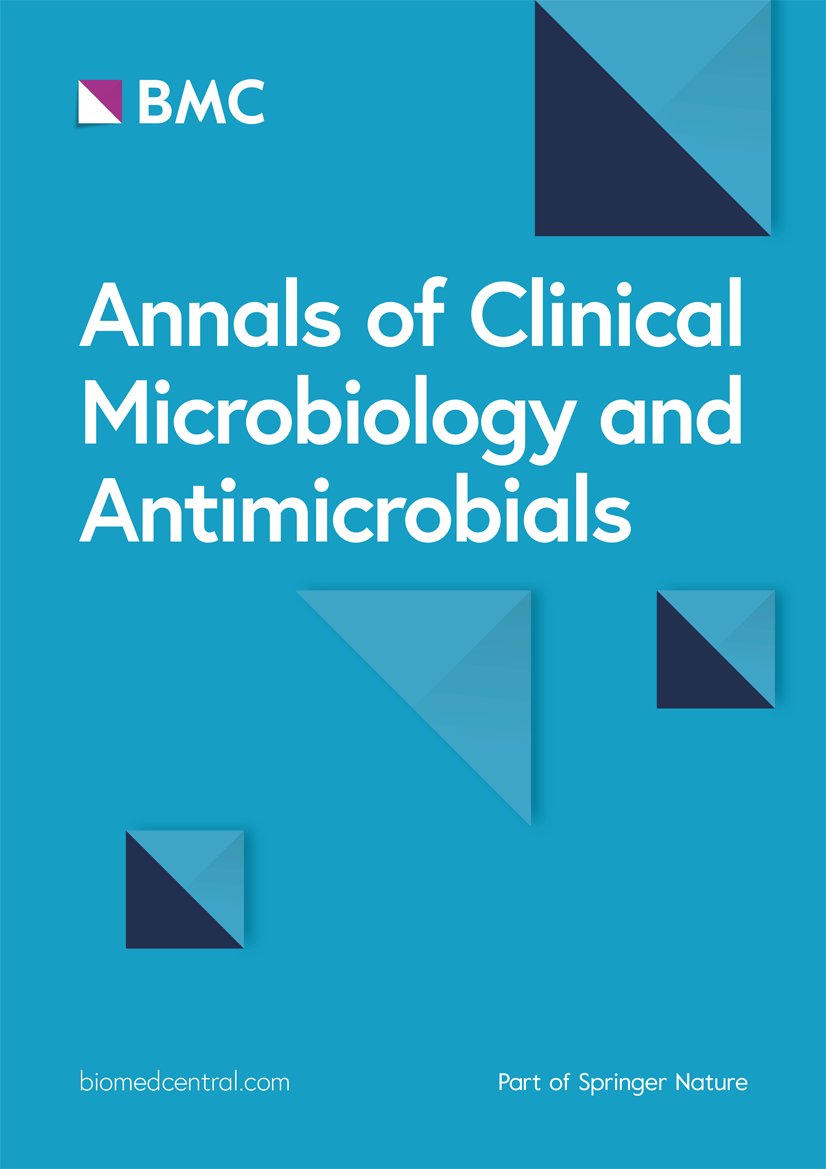Dynamic changes of respiratory microbiota associated with treatment outcome in drug-sensitive and drug-resistant pulmonary tuberculosis
IF 3.6
2区 医学
Q1 MICROBIOLOGY
Annals of Clinical Microbiology and Antimicrobials
Pub Date : 2024-09-09
DOI:10.1186/s12941-024-00742-y
引用次数: 0
Abstract
Respiratory microbiota is closely related to tuberculosis (TB) initiation and progression. However, the dynamic changes of respiratory microbiota during treatment and its association with TB progression remains unclear. A total of 16 healthy individuals and 16 TB patients (10 drug-sensitive TB (DS-TB) and 6 drug-resistant TB (DR-TB)) were recruited. Sputum samples were collected at baseline for all anticipants and after anti-TB treatment at Month-6 for TB patients. High throughput 16 S RNA sequencing was used to characterize the respiratory microbiota composition. Compared to the healthy individuals, TB patients exhibited lower respiratory microbiota diversity (p < 0.05). This disruption was alleviated after anti-TB treatment, especially for DS-TB patients. Parvimonas spp. numbers significantly increased after six months of anti-TB treatment in both DS-TB and DR-TB patients (p < 0.05). Rothia spp. increase during treatment was associated with longer sputum-culture conversion time and worse pulmonary lesion absorption (p < 0.05). Besides, Moraxella spp. prevalence was associated with longer sputum-culture conversion time, while Gemella spp. increase was associated with worsening resolving of pulmonary lesions (p < 0.05). Dynamic changes of respiratory microbiota during anti-TB treatment is closely related to TB progression. The involvement of critical microorganisms, such as Parvimonas spp., Rothia spp., Moraxella, and Gemella spp., appears to be associated with pulmonary inflammatory conditions, particularly among DR-TB. These microorganisms could potentially serve as biomarkers or even as targets for therapeutic intervention to enhance the prognosis of tuberculosis patients.呼吸道微生物群的动态变化与药物敏感性肺结核和耐药性肺结核的治疗结果有关
呼吸道微生物群与结核病(TB)的发生和发展密切相关。然而,治疗期间呼吸道微生物群的动态变化及其与结核病进展的关系仍不清楚。我们共招募了 16 名健康人和 16 名肺结核患者(10 名药物敏感型肺结核(DS-TB)患者和 6 名耐药型肺结核(DR-TB)患者)。所有预期者均在基线时采集痰样,肺结核患者则在抗结核治疗后第 6 个月采集痰样。采用高通量 16 S RNA 测序来描述呼吸道微生物群的组成。与健康人相比,肺结核患者的呼吸道微生物群多样性较低(p < 0.05)。在接受抗结核治疗后,尤其是 DS-TB 患者,这种紊乱有所缓解。DS-TB 和 DR-TB 患者在接受 6 个月的抗结核治疗后,Parvimonas 菌属数量明显增加(p < 0.05)。治疗过程中罗氏菌属数量的增加与痰培养转换时间延长和肺部病变吸收恶化有关(p < 0.05)。此外,莫拉菌属的增加与痰培养转换时间的延长有关,而革兰氏菌属的增加与肺部病变消退的恶化有关(P < 0.05)。抗结核治疗期间呼吸道微生物群的动态变化与结核病的进展密切相关。关键微生物(如 Parvimonas spp.、Rothia spp.、Moraxella 和 Gemella spp.)的参与似乎与肺部炎症状况有关,尤其是在 DR-TB 中。这些微生物有可能成为生物标志物,甚至成为治疗干预的目标,以改善肺结核患者的预后。
本文章由计算机程序翻译,如有差异,请以英文原文为准。
求助全文
约1分钟内获得全文
求助全文
来源期刊

Annals of Clinical Microbiology and Antimicrobials
MICROBIOLOGY-
CiteScore
8.60
自引率
0.00%
发文量
49
审稿时长
>12 weeks
期刊介绍:
Annals of Clinical Microbiology and Antimicrobials considers good quality, novel and international research of more than regional relevance. Research must include epidemiological and/or clinical information about isolates, and the journal covers the clinical microbiology of bacteria, viruses and fungi, as well as antimicrobial treatment of infectious diseases.
Annals of Clinical Microbiology and Antimicrobials is an open access, peer-reviewed journal focusing on information concerning clinical microbiology, infectious diseases and antimicrobials. The management of infectious disease is dependent on correct diagnosis and appropriate antimicrobial treatment, and with this in mind, the journal aims to improve the communication between laboratory and clinical science in the field of clinical microbiology and antimicrobial treatment. Furthermore, the journal has no restrictions on space or access; this ensures that the journal can reach the widest possible audience.
 求助内容:
求助内容: 应助结果提醒方式:
应助结果提醒方式:


